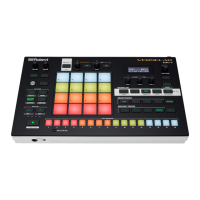6
Parameter List
Parameter Value Explanation
SLICE EXEC —
Press the [VALUE] dial to execute the slice.
Slices are used for dividing up a sample and
extracting multiple samples from the result.
Slice Point 1–256
Selects the samples to use from the sliced
sample.
EXPORT SAMPLE —
Press the [VALUE] dial to export the sample to
the SD card in WAV format.
Exported samples are saved in the ROLAND/
MV/SAMPLE/EXPORT folder of the SD card.
SYSTEM
CTRL
Make settings for the pads and knobs.
Parameter Value Explanation
Knob Mode
DIRECT,
CATCH
DIRECT: When a knob is moved, control
data of the corresponding position is always
output.
CATCH: Control data is output after the knob
passes through the current value of the
parameter.
Pad Trg Sens 10–200
Adjusts the sensitivity of the pads to repeated
strikes.
With lower values, the pads will accept
repeated strikes at a shorter time interval.
Increase this value if you don’t want repeated
strikes to be accepted inadvertently.
USBMix
PRE T-FX,
POST T-FX
Species whether sound that is input via the
USB-connected MIX OUT port is input before
or after TOTAL FX.
&
“Block Diagram” (p. 52)
Load Proj
LAST,
INIT
LAST: At startup, the project that was last
saved will be loaded.
INIT: At startup, a project will not be loaded.
A new project will be created.
Pad Cruve
LINER,
EXP,
LOG,
FIX10–127
Species how the volume changes in
response to the force of your strike on the
pad.
LINER: This is the normal setting. This allows
the most natural-feeling relation between
strike strength and volume change.
EXP: Compared to LINEAR, this produces
greater volume change for stronger strikes.
LOG: Compared to LINEAR, this produces
greater volume change for softer strikes.
FIX10–127: Enters a specied xed value.
Pad Thres 0–15
Species the pad’s minimum sensitivity so
that a trigger signal is read only if the pad is
struck more strongly than a specied level.
This can be used to prevent the pads from
picking up vibration from the environment.
Pad Trg Sens 10–200
Adjusts the sensitivity of the pads to repeated
strikes.
With lower values, the pads will accept
repeated strikes at a shorter time interval.
Increase this value if you don’t want repeated
strikes to be accepted inadvertently.
Pad Gain 0–100
Adjusts the pad sensitivity. This is valid when
Pad Curve Type is LINER, EXP, or LOG.
Increasing this value increases the sensitivity,
so that the maximum velocity can be
produced more easily.
MIDI
Parameter Value Explanation
Sync Src
AUTO,
INT,
MIDI,
USB
Species the tempo source.
If this is “AUTO”, the tempo automatically
synchronizes to MIDI clock if MIDI clock is
being input via the MIDI IN connector or the
USB port.
If this is “INT”, the tempo specied on the
MV-1 is used.
Parameter Value Explanation
Sync Out
OFF,
ON
Species whether clock, start, and stop
messages are transmitted (ON) or are not
transmitted (OFF) to the devices connected
to the corresponding MIDI port.
SyncOut USB
OFF,
ON
Species whether clock, start, and stop
messages are transmitted (ON) or are not
transmitted (OFF) to the USB-connected
device.
RX Start Stop
OFF,
ON
When synchronized to external MIDI clock,
this setting species whether the step
sequencer’s start/stop is controlled from the
device connected to the corresponding MIDI
port (ON) or is not controlled (OFF).
RX Start USB
OFF,
ON
When synchronized to external MIDI
clock, this setting species whether step
sequencer’s start/stop is controlled from
the USB-connected device (ON) or is not
controlled (OFF).
Track1–4 Ch 1–16 Species the MIDI channel of each track.
Device ID 17–32
When transmitting and receiving system
exclusive messages, the device ID numbers of
both devices must match.
Soft Thru
OFF,
ON
If this is ON, MIDI messages that are
input from the MIDI IN connector are re-
transmitted without change from the MIDI
OUT connector.
USB Thru
OFF,
ON
Species whether MIDI messages received at
the USB port or MIDI IN port are retransmitted
without change from the MIDI OUT connector
and USB port (ON) or not (OFF).
If this is ON, MIDI messages received at the
USB port are sent to the internal sound
engine and to the MIDI OUT connector,
and MIDI messages received at the MIDI IN
connector are sent together with messages
from the internal sound engine to the USB
port.
Edit Note OFF, ON
Sets whether the note messages received
from an external source via MIDI can change
what you are editing (ON) or not (OFF) while
you are editing a step.
DISPLAY
Parameter Value Explanation
Contrast 1–10 Adjusts the contrast of the display screen.
Backlight 1–10
Adjusts the brightness of the display
backlight.
LED Bright 1–10
Species the brightness of the fader and
button LEDs.
LED Glow 1–10
Adjusts the brightness when a button LED is
dimly lit.
Demo Mode OFF, 1min–10min
Species the time (minutes) until the LED
demo is shown.
Arpeggio
Parameter
Value Explanation
Style 1–128
Species the basic way in which the arpeggio
will be played.
Variation 1–
The arpeggiator provides several variations
(performance patterns) for each arpeggio
style. This parameter selects the variation
number. The number of variations will dier
according to the arpeggio style.

